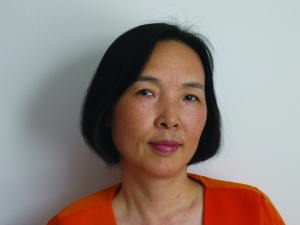Apr 07, 2005
|
|
|
Artist Zheng Ping (Epoch Times Photo) |
SR: Thank you for agreeing to this interview. Your painting is so beautiful-and so delicate. I wonder what the inspiration for this work was.
ZC: As a Falun Dafa practitioner, I first thought of how I could possibly carry to people the idea of wonderment of cultivation and the transcendence we who practice Falun Dafa may experience. Falun Dafa cultivates both the mind and body, and doing meditation can allow one to enter into a state of deep tranquility, and a moment that is solemn and sacred. I wanted to express this quality, this transcendental experience that Falun Gong can bring.
I wanted to show the purity of this experience. In this painting, the "Lotus Flower," a maiden sits in meditation. She gives one the impression of pure serenity, free of all mundane or worldly elements. Her hair is pinned up high to show the height her mind has reached. In the background are the lotus flowers, which also gives an otherworldly impression. The lotus is the symbol of purity and also the flower of the Buddha's paradise. In traditional Chinese culture the lotus shows the predestined relationship with the Buddha, and it is used as a symbol of one's attainment status, that is, how high one's spirit has ascended.
The pure maiden sits in front of the lotus that is the totally pure, not touched by this world.
SR: Your work looks like an example of a very traditional Chinese painting. Yet something about it seems modern to my Western eyes. Is this something intentional?
ZC: Basically, I combined the techniques of traditional Chinese painting with the use of watercolor in the Western tradition. I chose to combine these two traditions because I believe the traditional arts are gifts of the Divine, their realm of expression is high, and they can help lead people toward enlightenment of their spirits. I have studied Chinese painting for many, many years and really enjoy it.
At the same time, I'm fond of painting with watercolor. Before I left China, I taught watercolor at a university in China. Because of the possibilities in watercolor painting, the light gradation allowed by the gradation of color, the effect of the whole gives people a very strong sense of three-dimensional space.
In addition, although watercolor painting is a Western art, it shares some features with traditional Chinese painting. For example--the common element to both is the use of water as the basic medium. Both use a brush. In watercolor painting, the kind of pigment used is highly soluble, and one can manipulate the color easily and produce many subtle differences. The colors used in traditional Chinese paintings are highly soluble, too, so for me, traditional Chinese painting and watercolor painting are like sisters, very close to each other. If one can master the techniques and merge the two together, one can come up with a distinctive style.
SR: Other than talking about the painting's inspiration and the techniques used to achieve it, do you have anything else you'd like to share with our readers?
ZC: After I started practicing Falun Gong, some of my previous ideas about painting changed. Before I was fond of impressionistic and modern art. I have moved away from modern art, back to traditional art. In fact, now I think that modern art is kind of a warped idea, warped in the sense of moving away from that divine purpose of art, that is, to portray the pure, beautiful and holy. I believe that arts are a gift from the Divine, especially painting, something given to human beings.
But art depicting Buddhas and gods are not really appreciated today, and in fact are sometimes looked down upon. I have participated in many national and international painting exhibitions and, in my experience, paintings depicting what is holy have no chance of being selected for display. And this tendency is even greater in China. These kinds of painting simply are not selected for exhibitions.
I feel that the exclusion of gods and Buddha's, sacred pictures in general, reflect a warped notion--that we are not even willing to allow gods to be honored or displayed is just way-off base in my opinion.
Zhengping Chen, previously an art instructor in China, has had her work shown extensively in the U.S. (New York, California, New Orleans, Boston, West Virginia, Texas, to name a few) and in the Far East (Hong Kong, China) as well. She is a National Watercolor Society Signature Member since 1991 and the recipient of the West Virginia Artist Award.
Source: http://english.epochtimes.com/news/5-4-7/27659.html
All content published on this website is copyrighted by Minghui.org. Minghui will produce compilations of its online content regularly and on special occasions.
Category: Falun Dafa in the Media










